Castling in chess is not a move that you can just make anytime you feel like. There are certain conditions that must be met in order to safely and legally execute a short or longside castle.
There are generally 4 rules you need to know when castling in chess:
- Neither the king nor the rook has previously moved in the game
- There must be no pieces between the king and rook
- The path to which the king castles should not be controlled by an enemy piece.
- The King must not be in check
Conditions That Must Be Met For Castling
1. Neither the king nor the rook has previously moved in the game
You cannot castle if the king or the rook have already been moved in the game. For example, if you want to castle short on the kingside, but you already moved your h1 rook in the corner, then castling short is forbidden.
Similarly, if you wish to castle long for white, but your a1 rook already moved in the game, then you cannot castle queenside.
However, if you moved your a1 rook but wish to castle short on the kingside, then castling is allowed given that the h1 rook and the king on e1 did not move. Therefore, it all depends on the side you want to castle on.
Moving your queenside rook should not be a deciding factor when castling short. What counts was whether or not you moved your kingside rook. For example, in the position below, white can safely castle kingside though the a1 rook has been exchanged off the board.
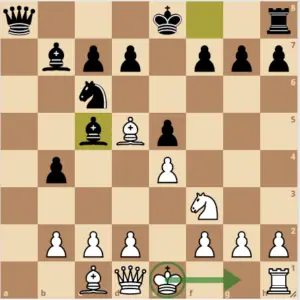
2. There must be no pieces between the king and rook
When castling, the king moves two squares towards the rook, then the rook jumps over and lands beside the king. The squares between the rook and the king should not be occupied by either your own pieces nor the enemy pieces.
For example, if white wants to castle kingside, then there should be no pieces on the f1 and g2 squares. Similarly, if white wishes to castle long, then there should be no pieces on the b1,c1 or d1 squares.
3. The path to which the king moves should not be controlled by an enemy piece.
The squares or path to which the king moves should not be conrolled by enemy pieces. For example, in the position below, white cannot castle long because the black bishop is controlling the c1 square which is the path to which the king moves when castling. Because it is illegal to put the king on an endangered square, then castling is forbidden in this case.
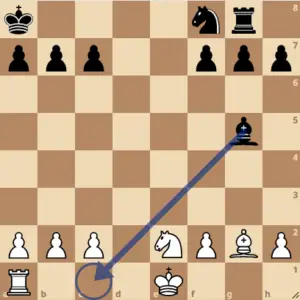
4. The King must not be in check
Quite a number of chess players make the mistake to castle out of check. This is illegal, but don’t ask me why. The rules stipulate that you cannot castle out of check. Instead, you must either block the attack with one of your pieces, capture the threat, or move your king one square safely to a legal square.
The position below shows black giving a check to the white king.
White cannot castle out of check
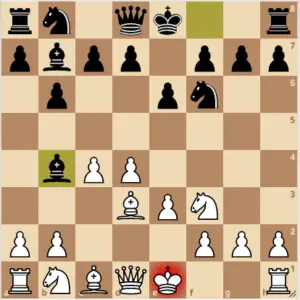
Here, white cannot castle out of check. Instead, he must block the check with his knight or bishop which are the best moves in the position. Or, he can move his king to f1 or e2 which are not the smartest of moves as white will no longer be able to castle.
Best Times To Castle In Chess
1. Castle Early In The Opening
The opening phase is the best time to castle in chess. This is the first few moves of a chess a game. The main aim of the opening is to develop your pieces onto their most active squares, after which you can formulate a winning plan moving forward.
The main reason you want to castle as early in the opening is to safeguard your king. If you leave the king too long in the center, you may never get the chance to castle as your opponent can use his pieces to cut off the path to which the king castles. In some positions, he can use his major pieces along the e-file to pin and prevent the king from ever castling.
Let’s look at one such example in the French Defense.
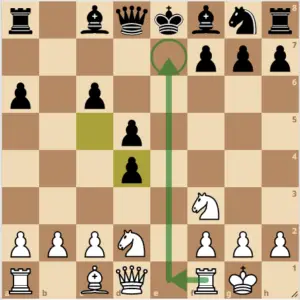
This position arrives from the Rubenstein variation after: 1.e4 e6 2.d4 d5 3.Nd2 c5 4.Ngf3 Nc6 5.exd4 exd4 6.Bb5 a6 7.Bxc6 bxc6 8.0-0 cxd4
Black abandons his kingside development by wasting a tempo capturing on d4. Meanwhile, white has completed his kingside development and is ready to punish black for keeping his king in the center.
9.Re1+ Be7 10. Nb3 Nf6 11.Nbxd4 (threatens Nc6) Qc7 12.Qe2!

White’s last move, Qe2, prevents black from castling. Note how white’s major pieces (rook and queen) are pinning down the bishop on e7. If Black decides to castle, he would lose the bishop on e7 after Qxe7. Black is going to have a very miserable game, and at least lose a pawn after 12…Ne4 13.Nd2 0-0 14.Nxe4 dxe4 15.Qxe4 (White stands good winning chances).
2. Castle Long When Launching Pawn Storms
Pawn storms in chess refers to an attack against the king in which the attacking side pushes forward his flank pawns towards the enemy king in an attempt to open lines and wreak havoc. This type of attack is common in many sicilian openings for example in the Yugoslav attack vs Sicilian Dragon.
The Yugoslav attack
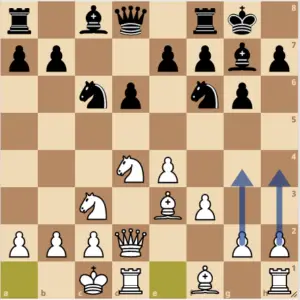
In this position, white managed to castle long and is now ready to launch his g and h pawns up the board to attack the black king. In some lines, white can go immediately for the attack or prepare it with Kb1 (a prophylaxis move that gets the king off the c1 to h6 diagonal and adds more protection to the a-pawn)
It’s best to castle long whenever you want to push your g and h pawns up the board. This way, your king will be safe while you carry out the attack.
You don’t want to start pushing your g and h pawns up the board when your king is still in the center as this can be very risky, especially if you are not an experienced player.
3. Castle To Activate The Rooks
Castling helps to activate your rook by moving it from the corner of the board into where the action is. In doing so, the rooks get to be connected to one another which is when they are at their best performance. You don’t want to have disconnected rooks as this can cause all sorts of troubles in your position.
A rook in the center is much more active than a rook in the corner. So whenever you want to connect your rooks, remember to castle.
Once you’ve castled and activated the rooks, you can begin to open lines along the files. Rooks work best on open files instead of closed files as they move up and down the chess board. Without open files, your rooks wouldn’t be worth anything.
When Not To Castle In Chess
So far, we’ve looked at the best times to castle in chess. But did you know that there are times when it’s bad to castle? Indeed. Castling can sometimes put your king in danger. Sounds interesting? Let’s look at the times when you should not castle:
1. Don’t Castle In The Endgame
You do not want to castle in the endgame. The endgame is the final stage of the game where players try to promote their pawns into a queen and checkmate the enemy king. The king becomes very important in the endgame. It needs to attend to the pawns by helping them up the board so that they can safely promote.
In the endgame, the king needs to move up to the center of the board to take control of key squares so that the enemy king doesn’t infiltrate the position.
The faster you can get the king to the center is the better. However, castling the king in the endgame puts the king further away from the center and into the corner of the board which is disadvantageous. This means it will take a longer time for the king to travel quickly to the center of the board to help gain control of key squares.
Meanwhile your opponent’s king would have already been out in the center where he now stands a better chance of winnning.
Sometimes, you don’t have to castle to activate your rooks. Its best to move your king one step up the board. In doing so, you not only activate your rooks, but you activate your king which is now closer to the center of the board than it would have been in the corner. Let’s look at an example:
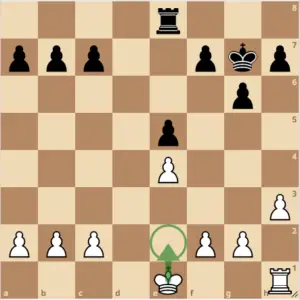
In this position, it would be foolish of white to castle kingside. This will not only bring his king farther from the center but it immediately gives Black control of the d-file with his rook.
White needs to play Ke2 which preserves the activity of his king, and supports the rook when it moves to the d-file. The white rook will need to challenge the black rook on the d-file. However, this could not have been possible without the King on e2.
2. Castling Can Be Too Slow
Castling can be too slow. For example, your opponent makes an inaccaurate move in the opening and you wish to capitalize on the mistake. If you don’t hurry to exploit your opponents mistake, he can neautralize back the position and your advantage may disappear.
Strong players know when not to castle. They know when to keep the king in the center and to remain flexible. But this will only come with practice and learning.
However, if you haven’t reached master level as yet, then it is highly recommened that you castle to safeguard your king. It’s better to be on the safe side.
3. Don’t Castle The King Where There Is Enemy Pieces
Avoid castling your king where there is danger. For example, if your opponent’s pieces and pawns are all concentrated on the kingside, then it’s best to castle on the queenside to avoid any potential attack. You can learn more about long castling here.
Similarly, if your opponent’s pieces are eyeing the queenside, then castling short is the smartest decision to make. Just observe the position properly to see whether it is safe to castle long or short. If there are little to no pieces eyeing the kingside, then you can safely castle short. The same goes for the queenside.
Final Verdict
Knowing when to castle is very important in chess and is actually a skill you need to master. Sometimes it’s best to castle kingside, other times it’s best to castle queenside, while sometimes it’s best to just leave the king in the center. Nevertheless, you should always prioritize king safety over everything else.


